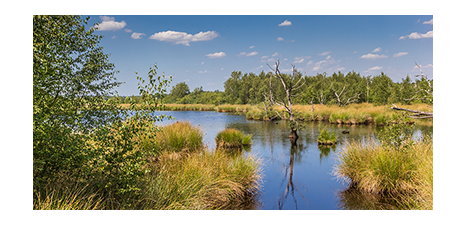

Before settlement of Ohio nearly one-fifth of the state was covered in wetlands. Now, over ninety percent of the wetlands have been drained or filled to be developed for our increasing population.
Wetlands are very significant to our water quality and flood control. The plants in a wetland filter out sediment and other pollutants improving water quality. These low lying areas serve as huge detention areas for storm water. Think of the wetlands as the earth's storm water detention system. Also, wetlands provide recrea tional opportunities like fishing, hunting, and birdwatching. Not to mention the critical habitat for many species of plants and animals.
tional opportunities like fishing, hunting, and birdwatching. Not to mention the critical habitat for many species of plants and animals.
Animals you may see in Trumbull County's wetlands:
There are many kinds of wetlands in Ohio: bogs, fens, wet prairies, marshes, swamps, wet woods, and vernal pools. What they all have in common is that they have 1) water at or near the surface during some part of the growing season, 2) hydric soils that lack oxygen, and 3) plants that are adapted to life in these saturated conditions.
Wetland Hydrology: Wetlands have either saturated or flooded soils for at least seven days during the growing season. Some wetlands may appear dry much of the year but still have wetland hydrology during the growing season.
Hydric Soils:Wetlands have poorly drained soils which develop an anaerobic (devoid of oxygen) surface layer due to saturation or flooding. You can look for hydric soils located in Trumbull County (listed below) in free Soil Survey books located at Trumbull Soil & Water Conservation District.
Trumbull County List of Hydric Soils
- Cb- Canadice silty clay loam
- Ch- Carlisle muck, ponded
- Ct*- Condit silt loam
- Da(Od)*- Damascus loam
- Ho*- Holly silt loam, frequently flooded
- Lo*- Lorain silty clay loam
- Lp*- Lorain silty clay loam, loamy substratum
- Sb*- Sebring silt loam
- Sc (Sf)*- Sebring silt loam, till substratum
- Tr- Trumbull silty clay loam
Hydrophytic Vegetation:Wetlands have vegetation that is adapted to life in saturated or flooded soil conditions. The familiar cattail is just one of over 1000 plants species which commonly occur in Ohio's wetlands. Others include trees, shrubs, vines, and grasses.
The Clean Water Act requires permits to be obtained for any disturbance in a wetland. Depending on the wetland an individual needs either a: 401 permit from the Ohio Environmental Protection Agency for wetlands isolated from waterways or 404 permit from the Army Corps of Engineers for wetlands that are connected to waterways.
Disturbances activities include, but are not limited to:
If you plan to disturb wetlands on your property, then contact:
Army Corps of Engineers
1000 Liberty Avenue
Pittsburgh, PA 15222-4186
(412) 395-7152
Fax: (412) 644-4211
Ohio Environmental Protection Agency
Division of Surface Water-401/Wetland Section
122 South Front Street
P.O. Box 1049
Columbus, Ohio 43216-1049
(614) 644-2139
Fax: (614) 644-2745